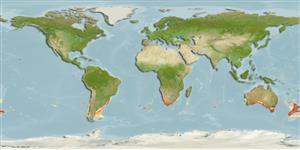Environment: milieu / climate zone / depth range / distribution range
Sinh thái học
Biển gần đáy; Mức độ sâu 50 - 854 m (Ref. 52581). Subtropical; 28°S - 50°S, 180°W - 180°E
Circumglobal in southern waters: (Ref. 7300): South Africa, Australia, New Zealand, Kermadec I., Desventuradas Is., Juan Fernandez Is., Chile, north to southern Brazil, Tristan da Cunha.
Length at first maturity / Bộ gần gũi / Khối lượng (Trọng lượng) / Age
Maturity: Lm 88.0 range ? - ? cm
Max length : 160 cm TL con đực/không giới tính; (Ref. 89467); common length : 100.0 cm TL con đực/không giới tính; (Ref. 9258); Khối lượng cực đại được công bố: 100.0 kg (Ref. 4537); Tuổi cực đại được báo cáo: 60 các năm (Ref. 41439)
Các tia vây lưng cứng (tổng cộng): 9 - 12; Các vây lưng mềm (tổng cộng): 12; Tia cứng vây hậu môn 3; Tia mềm vây hậu môn: 7 - 9
A deepwater species, occurs in seamounts (Ref. 89357). Adults occur generally over rough ground from the central shelf (about 100 m) to the shelf edge and down to the upper slope. Juveniles are found in surface waters, perhaps school in association with drifting weed. Feed on barracouta and pilchards, in addition to various bottom-dwelling fish. Are primary gonochorists (Ref. 58421). Preyed upon by sperm whales (Ref. 9072). It is taken by droplining down to 400 m, and is sometimes seen in the trawled catch. Utilized fresh and frozen; can be steamed, fried, broiled, boiled, microwaved and baked (Ref. 9988). Severely overfished (Ref. 89357).
Are primary gonochorists (Ref. 58421).
Paxton, J.R., D.F. Hoese, G.R. Allen and J.E. Hanley, 1989. Pisces. Petromyzontidae to Carangidae. Zoological Catalogue of Australia, Vol. 7. Australian Government Publishing Service, Canberra, 665 p. (Ref. 7300)
IUCN Red List Status (Ref. 130435)
Threat to humans
Harmless
Human uses
Các nghề cá: Tính thương mại; cá để chơi: đúng
Các công cụ
Special reports
Download XML
Các nguồn internet
Estimates based on models
Preferred temperature (Ref.
123201): 8.6 - 16, mean 11.7 °C (based on 143 cells).
Phylogenetic diversity index (Ref.
82804): PD
50 = 0.8125 [Uniqueness, from 0.5 = low to 2.0 = high].
Bayesian length-weight: a=0.01072 (0.00765 - 0.01500), b=2.99 (2.89 - 3.09), in cm total length, based on LWR estimates for this species (Ref.
93245).
Mức dinh dưỡng (Ref.
69278): 4.5 ±0.77 se; based on food items.
Thích nghi nhanh (Ref.
120179): Rất thấp, thời gian nhân đôi của chủng quần tối thiểu là hơn 14 năm (tm=10-13; tmax=60).
Fishing Vulnerability (Ref.
59153): High vulnerability (59 of 100).
Climate Vulnerability (Ref.
125649): High to very high vulnerability (70 of 100).
Nutrients (Ref.
124155): Calcium = 34 [20, 61] mg/100g; Iron = 0.904 [0.538, 1.528] mg/100g; Protein = 21 [20, 22] %; Omega3 = 0.563 [0.318, 1.046] g/100g; Selenium = 55.6 [29.6, 108.8] μg/100g; VitaminA = 9.09 [3.16, 24.94] μg/100g; Zinc = 0.368 [0.267, 0.532] mg/100g (wet weight); based on
nutrient studies.
